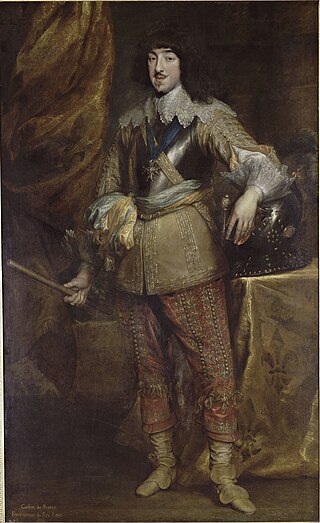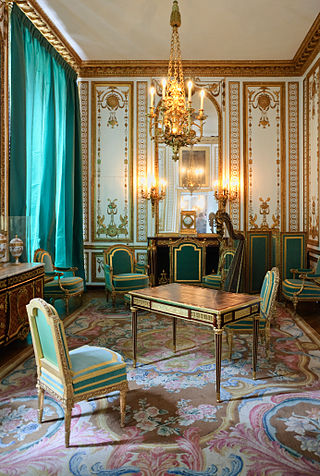Early life
Jean-Baptiste Veyren was born on 25 December 1707 in Villeneuve-de-Berg, in the Ardèche, rural Southern France. His father, Jacques Veyrenc, was a master locksmith. His mother was the former Anne Amblard.

Jean-Baptiste Veyren | |
|---|---|
| Born | Jean-Baptiste Veyren 25 December 1707 |
| Died | 9 April 1788 (aged 80) |
| Occupation(s) | Locksmith, ironworker |
| Spouses |
|
| Parent(s) | Jacques Veyrenc Anne Amblard |
Jean-Baptiste Veyren (a.k.a. Jean Veyren) (1707-1788) was a French locksmith and ironworker.
Jean-Baptiste Veyren was born on 25 December 1707 in Villeneuve-de-Berg, in the Ardèche, rural Southern France. His father, Jacques Veyrenc, was a master locksmith. His mother was the former Anne Amblard.

He designed ironworks for the Valloires Abbey in Argoules, Somme. [1] He also designed the chancel rail inside the Amiens Cathedral.
He designed an ironwork gate for the Château d'Heilly, which was moved to the Château de Bertangles in 1840. [2] He also designed the gate of the Château d'Hénencourt.
He married Marie-Jeanne Papillon on 8 January 1737 in Fouilloy. She died in 1745. He was married secondly to Marie-Louise Euvremer-Duval on 3 October 1747.
He died on 9 April 1788.

Palace of Fontainebleau, located 55 kilometers southeast of the center of Paris, in the commune of Fontainebleau, is one of the largest French royal châteaux. The medieval castle and subsequent palace served as a residence for the French monarchs from Louis VII to Napoleon III. Francis I and Napoleon were the monarchs who had the most influence on the palace as it stands today. It became a national museum in 1927 and was designated a UNESCO World Heritage Site in 1981 for its unique architecture and historical importance.

MonsieurGaston, Duke of Orléans, was the third son of King Henry IV of France and his second wife, Marie de' Medici. As a son of the king, he was born a Fils de France. He later acquired the title Duke of Orléans, by which he was generally known during his adulthood. As the eldest surviving brother of King Louis XIII, he was known at court by the traditional honorific Monsieur.

Anne Louise Bénédicte de Bourbon was the daughter of Henri Jules de Bourbon, Prince of Condé, and Anne Henriette of Bavaria. As a member of the reigning House of Bourbon, she was a princesse du sang. Forced to marry the Duke of Maine, legitimised son of Louis XIV and Madame de Montespan, she revelled in politics and the arts, and held a popular salon at the Hôtel du Maine as well as at the Château de Sceaux.

The French National Museum of Natural History, known in French as the Muséum national d'histoire naturelle, is the national natural history museum of France and a grand établissement of higher education part of Sorbonne Universities. The main museum, with four galleries, is located in Paris, France, within the Jardin des Plantes on the left bank of the River Seine. It was formally founded in 1793 during the French Revolution, but was begun even earlier in 1635 as the royal garden of medicinal plants. The museum now has 14 sites throughout France.

La Flèche is a town and commune in the French department of Sarthe, in the Pays de la Loire region in the Loire Valley. It is the sub-prefecture of the South-Sarthe, the chief district and the chief city of a canton, and the second most populous city of the department. The city is part of the Community of communes of the Pays La Flèche. The inhabitants of the town are called Fléchois. It is classified as an area of art and history.

Jean-Baptiste Antoine Colbert, Marquis de Seignelay was a French politician. He was the eldest son of Jean-Baptiste Colbert, nephew of Charles Colbert de Croissy and cousin of Jean-Baptiste Colbert de Torcy.
Philippe Marquis de Villette-Mursay was a French naval commander.

Bertangles is a commune in the Somme department in Hauts-de-France in northern France.

Marie Victoire Sophie de Noailles, Countess of Toulouse, was a French noble and courtier. Her second spouse was Louis Alexandre de Bourbon, Count of Toulouse, the youngest legitimized son of King Louis XIV of France and his maîtresse-en-titre, Madame de Montespan.

Louis XVI style, also called Louis Seize, is a style of architecture, furniture, decoration and art which developed in France during the 19-year reign of Louis XVI (1774–1793), just before the French Revolution. It saw the final phase of the Baroque style as well as the birth of French Neoclassicism. The style was a reaction against the elaborate ornament of the preceding Baroque period. It was inspired in part by the discoveries of Ancient Roman paintings, sculpture and architecture in Herculaneum and Pompeii. Its features included the straight column, the simplicity of the post-and-lintel, the architrave of the Greek temple. It also expressed the Rousseau-inspired values of returning to nature and the view of nature as an idealized and wild but still orderly and inherently worthy model for the arts to follow.

The Château de Chamarande is a 17th-century French château in Chamarande, in the Essonne department.

Jacques Eléonor Rouxel de Grancey, Comte de Médavy was a French military officer and Marshal of France who fought in the Nine Years' War and the War of the Spanish Succession.

The Château du Bosc Théroulde is a château built in the 17th century near Bosc-Guérard-Saint-Adrien in the Seine-Maritime département of Normandy, France.

The Baroque garden was a style of garden based upon symmetry and the principle of imposing order on nature. The style originated in the late-16th century in Italy, in the gardens of the Vatican and the Villa Borghese gardens in Rome and in the gardens of the Villa d'Este in Tivoli, and then spread to France, where it became known as the jardin à la française or French formal garden. The grandest example is found in the Gardens of Versailles designed during the 17th century by the landscape architect André Le Nôtre for Louis XIV. In the 18th century, in imitation of Versailles, very ornate Baroque gardens were built in other parts of Europe, including Germany, Austria, Spain, and in Saint-Petersburg, Russia. In the mid-18th century the style was replaced by the less geometric and more natural English landscape garden.

Victurnien Jean-Baptiste Marie de Rochechouart, prince of Tonnay-Charente then 9th duke of Mortemart was a French general and politician. He came from the Mortemart branch of the house of Rochechouart, named after the barony of Mortemart in Haute-Vienne, later raised to a marquisate and finally in December 1650 to a peer-duchy.
Nicolas Paquin was an early pioneer in New France now Quebec, Canada), a carpenter and the ancestor of virtually all of the Paquins in North America.

The Château de Bertangles, also named Château de Clermont-Tonnerre, is a historic castle in Bertangles, Somme, Hauts-de-France, France.

Neoclassicism is a movement in architecture, design and the arts which was dominant in France between about 1760 to 1830. It emerged as a reaction to the frivolity and excessive ornament of the baroque and rococo styles. In architecture it featured sobriety, straight lines, and forms, such as the pediment and colonnade, based on Ancient Greek and Roman models. In painting it featured heroism and sacrifice in the time of the ancient Romans and Greeks. It began late in the reign of Louis XV, became dominant under Louis XVI, and continued through the French Revolution, the French Directory, and the reign of Napoleon Bonaparte, and the Bourbon Restoration until 1830, when it was gradually replaced as the dominant style by romanticism and eclecticism.
Jean-Baptiste Bouchardon was a 17th/18th-century French sculptor and architect.